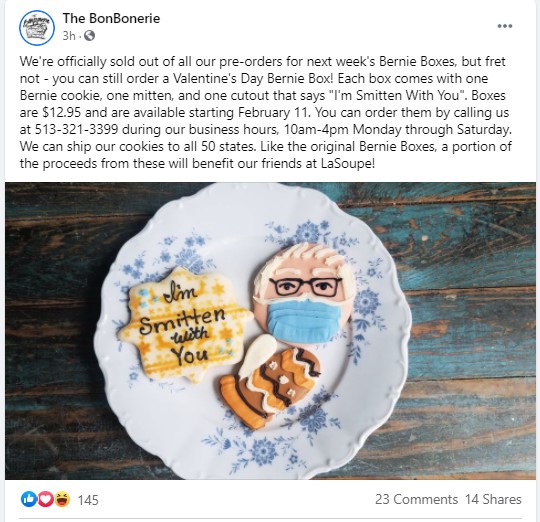I’m sure by now you’ve encountered the “Bernie’s Mittens” meme. You know, the one that was everywhere after the presidential inauguration last month.
In the unlikely event you missed it, here’s the rundown. A photographer snapped a photo of Senator Bernie Sanders (I-VT) during the televised ceremony. In it, Sanders sits in a folding chair at a respectable social distance, mask in place, arms and legs crossed against the cold. The snap quickly captured the hearts and meme-making imaginations of netizens everywhere.
What sparked people’s meme-making creativity was not the image itself. Instead, it was the senator’s fashion choices that caught viewers’ attention. Sanders was bundled up in a practical, drab-colored winter coat and cozy, oversized knit mittens in a stark contrast to the visual splendor of the event. He looked – as early versions of the meme pointed out – like someone who had merely squeezed the inauguration into his busy day.
Before the ceremony was even over, the meme took off on Twitter and other social media. People Photoshopped the image into famous works of art, album covers, movie scenes, and more. A meme generator briefly allowed would-be meme makers to drop Bernie’s image into any Google Maps Street View photo. (Texas Monthly compiled a list of Bernie in classic Texas locations.)
Sanders’ team put the image on a sweatshirt and donated the proceeds, raising $1.8 million for charities in Vermont. Even Ikea, Shopify, and many more brands used the moment to generate some interest for their products and services.
Memes and Public Conversation
For better or worse, internet memes have become a big part of public discourse online. This is because internet memes embody how conversations on social media happen. Techniques like reappropriation (borrowing content for another purpose) and collective participation are key features of today’s internet culture and conversation. Ryan Milner calls such characteristics memetic logics.
For some time, people have engaged in second-screening (think: watching something on TV and browsing social media). The fun comes from the combination of watching “together” by engaging in parallel social media conversation. The “Bernie’s Mittens” meme gave folks a way to participate in an inauguration that was otherwise closed to the public thanks to ongoing pandemic and security concerns.
People on both sides of the political aisle found the senator’s body language endearing, with a slightly grumpy-but-lovable grandfather figure vibe. The meme was politics-adjacent, without being political. You could like the meme without necessarily embracing Sanders’ political stances. It offered a chance to engage in a collective moment without cynicism or having to pick a side, a moment of humorous release after the tension of the preceding weeks.
…Bright Copper Kettles and Bernie in Mittens
So what made the Bernie’s Mittens meme take off?
Internet memes get their humor from a variety of techniques. These include intertextuality, juxtaposition, parody, and more. In other words, memes’ humor comes from a mash-up of content. Depending on their familiarity with the source texts referenced, not everyone will get the joke. In her research, Limor Shifman outlined several qualities that make a piece of content more likely to spark a meme. These are emotion, “ordinary” people, flawed masculinity, simplicity and repetitiveness, and whimsy.
The Bernie’s Mittens meme showcases many of these qualities. His attire and demeanor were a spot of “ordinary” amid the inauguration’s pageantry. As it took off, the meme concept itself was simple and repetitive: Put Bernie in his chair in other backgrounds. And someone unfamiliar with Sanders can still understand the meme. That’s because his image brings to mind familiar concepts, like grandpas, slightly bored impatience, casual indifference, being cold, and so on. These qualities, along with the larger context of folks looking for a little connection and lightheartedness, created a perfect recipe for a meme to go mainstream.
Trend-jacking Meme Marketing
As previously mentioned, multiple brands and businesses hopped on the meme. A Michigan-based real estate agent had her assistant Photoshop Bernie into some listing photos for a particular property. A bakery in Cincinnati combined two trends when it tied the Bernie’s Mittens meme to Valentine’s Day. Even brands overseas got in on this meme marketing.

Again, why does this happen?
Well, for one thing, brands want to go where their desired customers are. Landing a meme reference can pay dividends in good will and attention. Getting it right, however, requires having a deep understanding of both the target audience and the meme structure itself. This will help the brand’s social team get the humor, timing, and connection right in their meme marketing. Consider that once a meme has reached mainstream consciousness, it’s probably on its way out. This will matter more to some audiences than others.
On the other hand, getting meme marketing wrong can do significant damage to a brand’s reputation. A classic example is the time frozen pizza maker DiGiorno tried to jump on a trending hashtag, #WhyIStayed. The brand’s account tweeted “You had pizza.” The hashtag was about domestic violence survivors – not the right cultural moment to attempt to tie to frozen pizza through humor. Things said on social media can leave lingering consequences.
Meme marketing might be here to stay, but brands need to keep these factors in mind in order to protect their reputations. As for the state of public discourse… well, one meme won’t fix everything. But at least it gave us a moment to laugh together again.
Heidi Huntington
Assistant Professor of Business Communication
A few of my favorite memes

Source: Created with the Imgflip Meme Generator.


